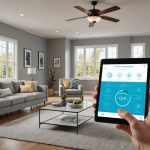Overview of Smart Home Technology
Smart home technology integrates various automated systems within a household to improve convenience, security, and energy efficiency. At its core, this technology involves interconnected devices that communicate through the Internet of Things (IoT). These devices range from smart thermostats to intelligent lighting systems, all designed to work together harmoniously. By utilising sensors and machine learning, smart homes can adapt to the preferences and habits of their users.
A primary function of smart home technology is energy management. Automated systems regulate energy use by adjusting heating and lighting based on occupancy, time of day, or weather conditions. For example, smart thermostats learn household routines and optimise heating schedules accordingly. This interconnectedness ensures minimal energy wastage, which is both cost-effective and environmentally friendly.
Also read : Transforming waste management in the uk: harnessing the power of ai for sustainable solutions
The benefits of adopting smart home systems extend beyond energy efficiency. Users gain enhanced control over their environment, often through a smartphone or voice-activated assistants. Such technology not only contributes to reduced energy bills but also offers a convenient lifestyle upgrade. Ensuring security and efficiency, these automated systems work seamlessly to enhance daily living while promoting sustainable practices.
Types of Smart Home Devices
Exploring smart home devices can greatly enhance both efficiency and comfort at home. Let’s dive into some of the most impactful smart devices available today.
Additional reading : Harnessing ai’s potential: revolutionizing predictive analytics in uk healthcare – discover the essential advantages
Smart Thermostats
Smart thermostats offer advanced features that streamline temperature control within your home. Popular models like Nest and Ecobee not only regulate heating and cooling but also adapt to your lifestyle. By learning your schedule, these devices efficiently manage temperature settings and can be controlled remotely via smartphone apps. An exciting aspect of smart thermostats is their energy-saving potential. According to studies, they can reduce heating and cooling bills by 10-15% annually, making them a worthy investment for homeowners keen on cutting costs.
Energy Monitors
Energy monitors serve as vigilant observers of your home’s energy consumption. These devices track usage in real time, providing insights that aid in making informed energy-saving decisions. Accessing detailed reports via apps allows you to spot energy-guzzling appliances and adjust your habits accordingly. Numerous case studies illustrate how homeowners have substantially reduced their energy bills by leveraging insights gained from energy monitors.
Automated Lighting Systems
Automated lighting systems revolutionise home illumination by optimising energy usage. Equipped with motion sensors and timers, they ensure lights are used only when needed. Moreover, integration capabilities with other smart devices promote cohesive, energy-efficient environments. Such systems simplify house management while offering financial and environmental benefits.
Benefits of Smart Home Technology for Energy Cost Reduction
Smart home technologies offer significant advantages for energy savings, transforming how households manage their home efficiency. These technologies primarily achieve cost reduction by automating energy use, optimizing utilities and promoting efficient energy habits.
One of the key advantages of smart home technologies is the ability to tailor energy usage according to specific needs. Smart thermostats, for instance, adjust heating and cooling based on occupancy and weather patterns, ensuring no energy is wasted. This automated adjustment can lead to impressive reductions in energy consumption, lowering utility bills substantially.
Moreover, smart lighting systems contribute notably to home efficiency. By using motion sensors and programmable schedules, unnecessary lighting use is minimized, further enhancing energy savings. Integrating these technologies into daily routines encourages households to adopt energy-saving practices with ease.
From a long-term perspective, adopting smart home technologies for energy management not only reduces home costs but also yields environmental benefits. Lower energy consumption means a reduced carbon footprint, aligning with sustainable living goals. Over time, these technologies pay for themselves through accumulated savings and increased home value, making them a prudent investment for environmentally-conscious homeowners.
Successful Implementation Case Studies
In today’s fast-paced world, many individuals are keen to learn from smart home success stories to enhance their own living spaces. Let’s dive into some compelling real-life examples that highlight effective smart home tech adoption.
One popular case study involves a large family living in the suburbs. By integrating smart thermostats, lighting systems, and security cameras, they achieved a more energy-efficient home. Not only did they reduce their electricity bills by 20%, but they also enhanced security and comfort, setting a benchmark for real-life examples in the smart home sphere.
Another noteworthy case is an urban apartment dweller who managed to optimize limited living space through smart tech. This individual employed strategies such as combining smart blinds with a central hub, achieving both aesthetic appeal and improved energy use. The outcome showcases how creativity, combined with technology, can transform lifestyle dynamics.
When examining these smart home success stories, common threads emerge. Homeowners often use smart energy meters to track consumption, aligning their use with peak energy times to optimize savings. Learning from these real-life examples, one can adopt tailored strategies to improve their household’s environmental footprint and functionality.
Practical Tips for Homeowners
Maximizing your home’s energy efficiency and setting up a smart home can significantly reduce energy consumption and save costs. Below are some practical insights to guide homeowners through the process.
Assessing Your Current Setup
The first step is to evaluate your existing energy consumption habits. Begin by analyzing your energy bills to identify patterns in usage. Look for areas in your home, such as lighting or heating systems, that frequently incur high energy costs. Smart technology upgrades in these areas can lead to significant cost reductions.
Identify the parts of your home that would most benefit from smart home tech. Spaces like the kitchen or living room often consume more energy through appliances and can benefit from smart gadgets. Prioritize upgrades that offer the best balance between cost and benefit—replacing outdated lightbulbs with LED versions is an example of a simple, cost-effective improvement.
Choosing the Right Devices
When selecting smart devices, ensure they fit seamlessly into your daily routine. Compatibility with existing technology is crucial; ensure devices like smart thermostats and lighting systems are easy to integrate. Consider budget-friendly options that effectively manage energy, such as smart plugs or energy monitoring devices, which can offer substantial savings over time.











